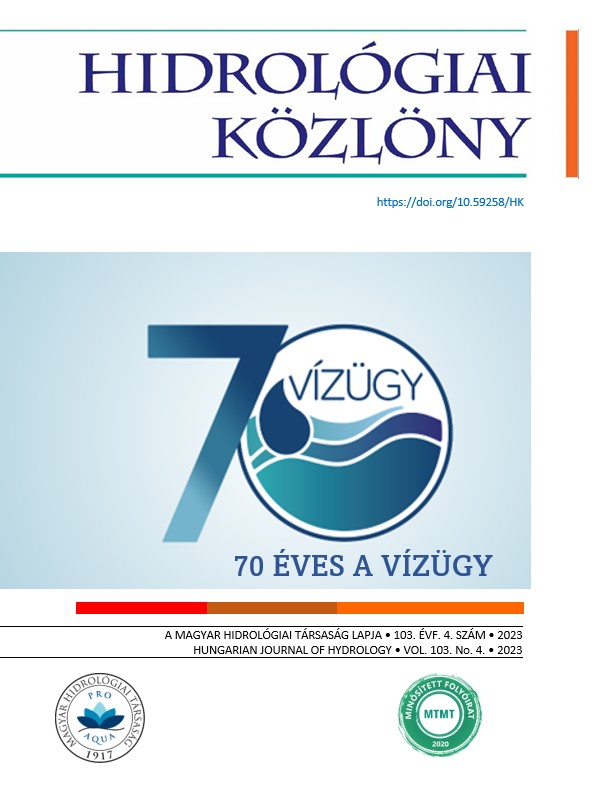A thermodynamics-based versatile evapotranspiration estimation method of minimum data requirement for water resources investigations in Hungary
Abstract
The author is an expert of the complementary relationship of evaporation. The thermodynamics-based versatile evapotranspiration estimation method of minimum data requirement (air temperature, humidity, wind speed, net radiation), presented in Hungarian for the first time is the pinnacle of twenty-two years of his research. The advantage of the method is that it contains only two easy-to-calibrate parameters (while outperforming complex methods of large data requirement) but can be employed in a calibration-free mode as well. This latter version again substantially outperforms the only other available such method (i.e., Morton’s WREVAP code) in almost every performance measure possible. All in all, it is a reliable and versatile evapotranspiration estimation approach that naturally lends itself for supporting catchment-level water management/allocation plans.
References
Bouchet, R. (1963). Evapotranspiration reelle et potentielle, signification climatique. International Association of Hydrological Sciences Publications, 62. pp. 134-142.
Brutsaert, W. (1982). Evaporation into the atmosphere: Theory, history, and applications, Dordrecht. Holland: D. Reidel. https://doi.org/10.1007/978-94-017-1497-6
Brutsaert, W. (2015). A generalized complementary principle with physical constraints for land-surface evaporation. Water Resources Research, 51(10). pp. 8087-8093. https://doi.org/10.1002/2015WR017720
Crago, R., Szilágyi, J., Qualls, R., Huntington, J. (2016). Rescaling the complementary relationship for land surface evaporation. Water Resources Research, 52(11). pp. 8461-8471. https://doi.org/10.1002/2016WR019753
Crago, R., Qualls, R. (2021). A graphical interpretation of the rescaled complementary relationship for evapotranspiration. Water Resources Research, 57(8). https://doi.org/10.1029/2020WR028299
Ma, N., Zhang, Y., Szilágyi, J., Guo, Y., Zhai, J., Gao, H. (2015). Evaluating the complementary relationship of evapotranspiration in the alpine steppe of the Tibetan Plateau. Water Resources Research, 51. pp. 1069-1083. https://doi.org/10.1002/2014WR015493
Ma, N., Szilágyi, J. (2019). The CR of evaporation: a calibration-free diagnostic and benchmarking tool for large-scale terrestrial evapotranspiration modeling. Water Resources Research, 55. https://doi.org/10.1029/2019WR024867
Ma, N., Szilágyi, J., Zhang, Y., Liu, W. (2019). Complementary-relationship-based modeling of terrestrial evapotranspiration across China during 1982-2012: Validations and spatiotemporal analyses. Journal of Geophysical Research: Atmosphere, 124. https://doi.org/10.1029/2018JD029850
Ma, N., Szilágyi, J., Józsa, J. (2020). Benchmarking large-scale evapotranspiration estimates: A perspective from a calibration-free complementary relationship approach and FLUXCOM. Journal of Hydrology, 590. https://doi.org/10.1016/j.jhydrol.2020.125221
Ma, N., Szilágyi, J., Zhang, Y. (2021). Calibration-free complementary relationship estimates terrestrial evapotranspiration globally. Water Resources Research, 57. e2021WR029691. https://doi.org/10.1029/2021WR029691
Monteith, J.L. (1981). Evaporation and surface temperature. Quarterly Journal of the Royal Meteorological Society, 107(451). pp. 1-27. https://doi.org/10.1002/qj.49710745102
Morton, F.I. (1983). Operational estimates of areal evapotranspiration and their significance to the science and practice of hydrology. Journal of Hydrology, 66. pp. 1-76.
Morton, F.I., Ricard, F., Fogarasi, F. (1985). Operational estimates of areal evapotranspiration and lake evaporation - Program WREVAP. NHRI Paper 24, National Hydrologic Research Institute, Saskatoon, Canada.
Pastorello, G., Trotta, C., Canfora, E., Chu, H., Christianson, D., Cheah, Y.W., Poindexter, C., Chen, J., Elbashandy, A., Humphrey, M., Isaac, P. (2020). The FLUXNET2015 dataset and the ONEFlux processing pipeline for eddy covariance data. Scientific Data, 7(1). p. 225. https://doi.org/10.1038/s41597-020-0534-3
Penman, H.L. (1948). Natural evaporation from open water, bare soil and grass. Proceedings of the Royal Society A: Mathematical, Physical and Engineering Sciences, 193, pp. 120-145. https://doi.org/10.1098/rspa.1948.0037
Priestley, C.H.B., Taylor, R.J. (1972). On the assessment of surface heat flux and evaporation using large-scale parameters. Monthly Weather Review, 100(2). pp. 81-92. https://doi.org/10.1175/1520-0493(1972)100<0081:OTAOSH>2.3.CO;2
Qualls, R.J., Crago, R.D. (2020). Graphical interpretation of wet surface evaporation equations. Water Resources Research, 56, e2019WR026766. https://doi.org/10.1029/2019WR026766
Szilágyi J. (2014). Temperature corrections in the Priestley-Taylor equation of evaporation. Journal of Hydrology, 519. pp. 455-464. https://doi.org/10.1016/j.jhydrol.2014.07.040
Szilágyi J. (2015). Complementary relationship-based 30-year normals (1981-2010) of monthly latent heat fluxes across the contiguous United States, Water Resources Research, 51. pp. 9367-9377, https://doi.org/10.1002/2015WR017693
Szilágyi J. (2018). A calibration-free, robust estimation of monthly land surface evapotranspiration rates for continental-scale hydrology. Hydrology Research, 49. https://doi.org/10.2166/nh.2017.078
Szilágyi J. (2021). On the thermodynamic foundations of the complementary relationship of evaporation. Journal of Hydrology, 593. 125916. https://doi.org/10.1016/j.jhydrol.2020.125916
Szilágyi J., Józsa J. (2008). New findings about the complementary relationship-based estimation methods. Journal of Hydrology, 354(1-4). pp. 171-186. https://doi.org/10.1016/j.jhydrol.2008.03.008
Szilágyi, J., Schepers, A. (2014). Coupled heat and vapor transport: The thermostat effect of a freely evaporating land surface. Geophysical Research Letter, 41, https://doi.org/10.1002/2013GL058979
Szilágyi, J., Crago, R.D. (2023). A thermodynamics-based versatile evapotranspiration estimation method of minimum data requirement for water resources investigations. Journal of Hydrology, 624, 129917. https://doi.org/10.1016/j.jhydrol.2023.129917
Szilágyi, J., Parlange, M.B., Katul, G.G. (2014). Assessment of the Priestley-Taylor parameter value from ERA-Interim global reanalysis data. Journal of Hydrology and Environmental Research, 2(1). pp. 1-7. https://snr.unl.edu/szilagyi/Szilagyi et al_off print.pdf
Szilágyi, J., Crago, R., Qualls, R. (2017). A calibration-free formulation of the complementary relationship of evaporation for continental-scale hydrology. Journal of Geophysical Research: Atmosphere, 122(1). pp. 264-278. https://doi.org/10.1002/2016JD025611
Szilágyi, J., Ma, N., Crago, R.D., Qualls, R.J. (2022). Power-function expansion of the polynomial complementary relationship of evaporation. Water Resources Research, 58(11). e2022WR033095. https://doi.org/10.1029/2022WR033095
Tetens, O. (1930). Über einige meteorologische Begriffe. Zeitschrift für Geophysik, 6. pp. 297-309.
Copyright (c) 2023 József Szilágyi

This work is licensed under a Creative Commons Attribution-NonCommercial-ShareAlike 4.0 International License.




